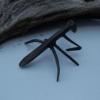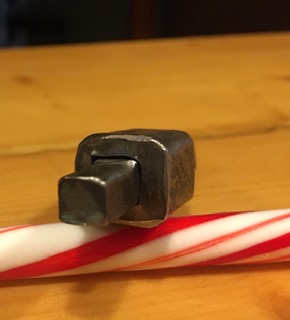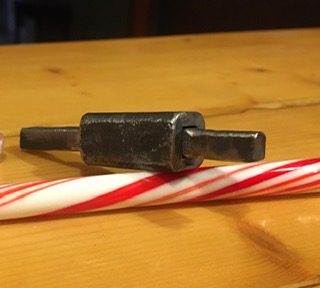-
Posts
297 -
Joined
-
Last visited
Content Type
Profiles
Forums
Articles
Gallery
Downloads
Events
Everything posted by rustyanchor
-

Need some advice on making a square hole.
rustyanchor replied to BillyBones's topic in Blacksmithing, General Discussion
Glenn, Anyone can teach me something if I am willing to learn...I got my learnin' for the day, now I'm good for the rest of the day ! Billy, Had my share of skunks a couple of years ago, they seemed to be all over the property, big ones and little ones running rampant. I had a primarily white one with black trim, really pretty, from a respectable distance. As proof of concept for my 5/8" with a hole drilled in it, I made a doodad. 5/8" round stock with a centered 11/32" hole drilled length wise. Mine was a bit off, I was using my mini wood lathe to try to do a good centered hole. Heat the newly formed 'pipe', put 1/4" sq. stock (mandrel) in the hole and forge the 5/8" down to 1/2" square. I had orig. thought to push the mandrel out, but the door handles already have a 1/4" square hole, so why push it out? Any way here is my crude attempt, it could be cleaned up and tweaked to work, I think. -

Need some advice on making a square hole.
rustyanchor replied to BillyBones's topic in Blacksmithing, General Discussion
I used to have a 'shop cat', that would hang out in the shop with me, and bring me 'snacks' (usually moles). He would hop on the anvil for rubs and scratches. When we got him, he needed a name, he was a black cat with a white V on his chest and he had pointy ears, so he got the name Vulcan. I started playing with metal after we got him, so the name fit him pretty well. I miss my shop buddy. -

Need some advice on making a square hole.
rustyanchor replied to BillyBones's topic in Blacksmithing, General Discussion
Billy, Since the mint cookies are off the table, I will be un-available for further un-expert advice, but... 5/8" round stock with a thru hole (diagonal measure of your 1/4" stock for diameter)bored the length of it. Heat and forge to 1/2"on a lubed 1/4" mandrel. If mandrel gets stuck, you can drive it out from the opposite end, since you have a thru hole. Cat skinning 101...I think -

Need some advice on making a square hole.
rustyanchor replied to BillyBones's topic in Blacksmithing, General Discussion
I'm still going with the tube theme....Thick wall round tube forged square? I don't have the skill to broach and all that, so I cheat. -

Need some advice on making a square hole.
rustyanchor replied to BillyBones's topic in Blacksmithing, General Discussion
Not sure if anyone makes 1/2" square tube with 1/8" walls, but it might be worth a look. I do have some 1/2" square tube,but walls are thinner than 1/8". -
You could make the horizontal cut in the stump with a saw and then split the side off with an axe. I should work fine as long as the stump has straight grain. Some wood will give a nice straight split, some is very twisted and will not give you a clean side. I burn wood in the winter, and have learned the hard way that, some wood is not worth trying to split by hand. One of my neighbors had a hydraulic splitter he loaned me, HA I now laugh at your twisted grain Mr log. Another neighbor cut and sold fire wood as a side job for many years. He has patiently shown and taught me how to use a saw without a trip to the ER every time. A sharp chain is your friend. I want to see pics when you get it done.
-
Nice Christmas present. I like 36 grit flap wheel sanding disks for metal work, they do a pretty good job of removing material. I can also get softer contours and curves with the flap wheels than a standard grinding disk. If you are leery of using a chain saw, what other tools do you have that could be used to remove wood? Personally, I would use the chain saw, you could try a hand saw, or chisel, if you have the patience. You could grind a flat with a belt sander, or flap wheel on the grinder, but lots of saw dust. I make the assumption that you are wanting to carve a flat on one side to mount the track. If you want to stand the track in the middle of the stump, drill and chisel, or plunge to depth with a chain saw, then chisel out the waste. Many ways to skin a cat, use what you have and are comfortable using. Good luck !
-
Not made by the same company. Vulcan's were made by Illinois Iron & bolt Co. of Carpentersville, Il. A & H were made by Columbus Anvil and Forging Co. of Columbus, Oh. Trenton was made by Columbus Forge and Iron Co. Trentons were not made in Trenton, but Fishers were... Trentons were made about 2 miles from where A & Hs were made and sometimes both companies used bases from the same foundry. A&H was started by a former CFI employee. All the above info is from AIA, without AIA and IFI as refs., I would be completely useless...Even with references, my wife has her doubts about my usefulness...
-
If my conversions are close, that would a decent price per pound here. Not as good per Kg-less Kg per Pound Sterling ! I don't know how big is too big for what you intend to use the anvil for. In actual footprint size, a 250 pound anvil is not really, that much, bigger than a 100 pound. An old Trenton ad had dimensions for various sized anvils. A 250 pound Trenton was 10 inches longer and 2 inches taller, the face was about an inch wider and 6 1/2" longer than their 100 pound anvil. Not like sacks of feed, double the weight, double the footprint... I wonder if Pfiel & Co was like Sears and many other retailers here, had the some tools made by other companies and rebranded them. I like your vise, looks like an oldie. If it does come home with you please post pics...
-
Amazing and beautiful build, it is hard to imagine that you can actually do real forging on a "baby anvil" Everybody always says (including me) you need mass under the hammer. Well I am beyond amazed at what you accomplished with a 425 pound(must be pounds, could be Kilos) couldn't be grams, anvil. I have watched your videos on forging a flower from scrap nails, wrought iron, and building an anvil. I am always amazed at what an accomplished 'smith can do.
-

Yet another what is it
rustyanchor replied to bluerooster's topic in Anvils, Swage Blocks, and Mandrels
Look at the bright side: The HB is only half used up, the English anvil will not make you feel like a heel if you pay $500 and buy it. Best of luck in your hunt. -
If you wanted to, you could send that nice little lathe and anvil over here for a vacation.... Think I goofed the weight, 2 0 26 would be 250, please don't ask for Kg, as I will mess that up even worse! If ring and rebound are good and the price is right, it would be a nice addition to a shop. Good luck with it
-
I could have been wrong in my previous post. I am not an expert and did not intend to pretend to be one. I have run across 2 forged A&Hs that I were both stamped, 2 is not a valid sample size !!! The couple of raised logos with an arm holding a hammer were cast iron Vulcans, again not enough for a valid sample. Most of what I think I know, comes from a single source, AIA, and for the most part the research is good. Black Frog was filling in some missing data, I don't know how much he found, and he hasn't posted in a while.
-
Pfeil&Co, London, warranted??? There is more but I cannot make it out. 132 or 244 pounds, I can't make out the first number. Interesting that the weight is stamped on the opposite side from most I have seen documented. Post 1830 (it has a pritchel) or so English wrought anvil in pretty good shape. I love the kind of rough finishing.
-

hay budden serial number
rustyanchor replied to Cat scratch forge's topic in Anvils, Swage Blocks, and Mandrels
Wine, flowers, and chocolate usually don't get you far dating anvils, they are into more of a "Lets get hammered and play with hot steel" kind of date. AIA says 1894. -
Jobtiel, Looks like it is ready to go back to work. Nice job. I don't see anything in your posts that I would consider rude. It seems like most people on this site are pretty easy going, and understand that we all don't have degrees in English from Oxford or Cambridge. I flat out guarantee that your English is better than my (fill in the blank for language). Be good!
-

Precut Angel Blanks
rustyanchor replied to Pat Masterson's topic in Blacksmithing, General Discussion
Where there is a will, and tools...you can make angels! That looks very nice. -

TPAAAT wins again! (also, please help identify)
rustyanchor replied to Flynn's topic in Anvils, Swage Blocks, and Mandrels
Looking at AIA, Mr P writes that some of the earliest Trentons were made in Germany and some were look like they were made by Peter or Henry Wright. A Peter or Henry if: The weight is below where the the trademark should be; a circular "solid wrought"; flat bottomed forged base, no S/N, with stepped feet. Mr P does not say if the Wright made anvils had the weight in pounds or CWT. I saw what I believe was a German Trenton and the weight was in pounds, That one was marked as a Trenton with the weight under the trademark. I think I am reading AIA right, if so it looks like a Wright well made anvil. -

TPAAAT wins again! (also, please help identify)
rustyanchor replied to Flynn's topic in Anvils, Swage Blocks, and Mandrels
German made Trenton?? Too lazy to dig in AIA...BUT at $250, if it rings and rebounds, it is a very nice deal and looks to be in beautiful shape. -
AIA is a great book, good job to your wife for ordering a nice Christmas/Hanukkah present. Richard Postman did a heck of a job researching and documenting anvils and the companies that made and sold them, there is still a ton of info out there he hadn't found when the book was published. Hopefully someday new info will be added. Some of the ads reprinted in AIA can give you at least a rough date range, it is a shame the feet are so corroded, the S/N would have given you exactly the info you seek. In any case you have a very nice family heirloom. My H Hudson Tool Co anvil was painted yellow when I got it, a wire wheel and some time got the paint off. I didn't polish it, I just took the paint off and let the "patina" stay. (When you get your AIA, see who made Hudson anvils and who sold them).
-

New to Forum, Help with Anvil ID and year
rustyanchor replied to Moemdown's topic in Anvils, Swage Blocks, and Mandrels
Welcome. AIA says 1902 -
George, I have at least 3 standing dead ash thanks to the emerald ash borer, and a few more they haven't killed yet. In a few years, ash may be like chestnut and elm, very little left standing in the wild, and too valuable as resistant breeding stock, to cut for it's traditional uses. Hopefully the borers don't decide they like ash's cousins pecan and hickory. I also have some sort of borers eating thru my pines. Just great.


